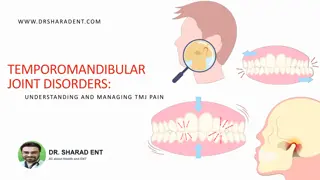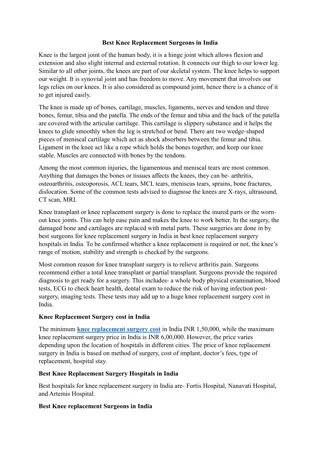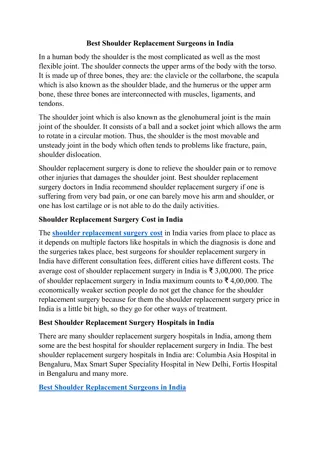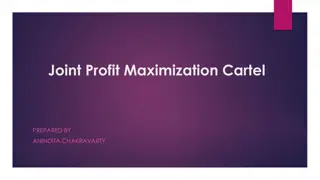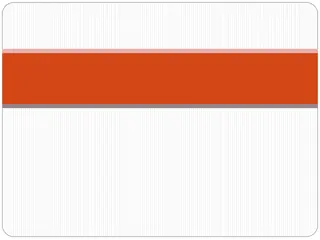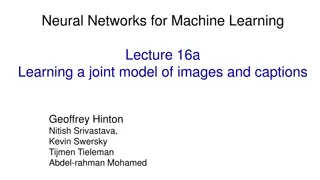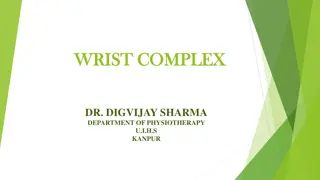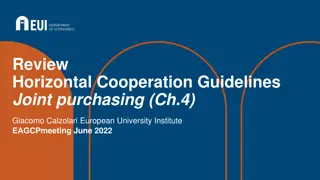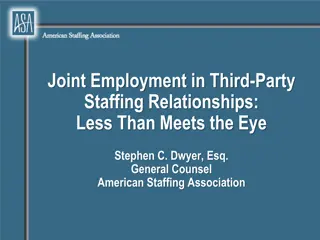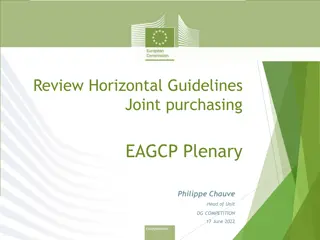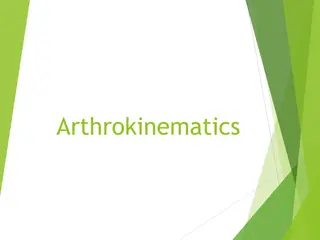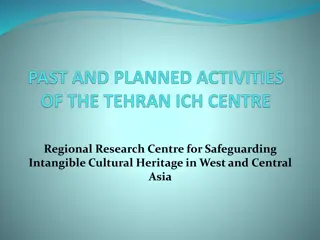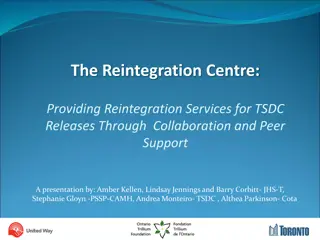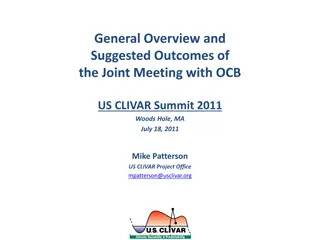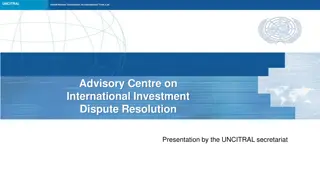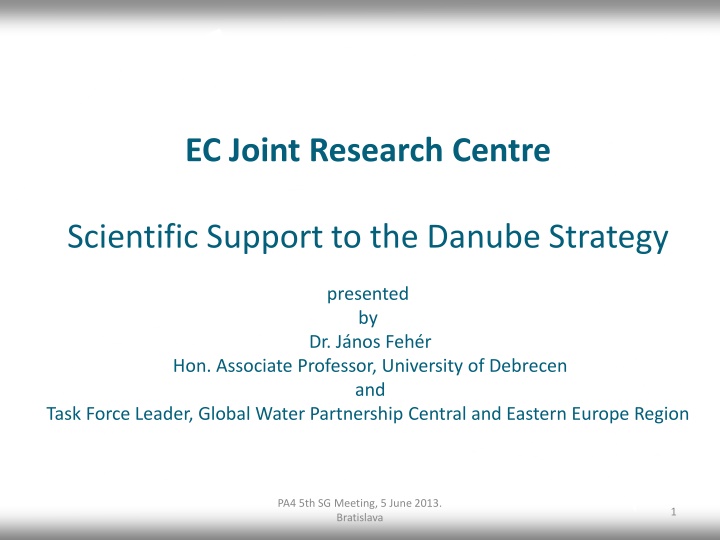
EC Joint Research Centre
The European Commission's Joint Research Centre provides scientific support to the Danube Strategy through flagship clusters focusing on environmental protection, irrigation and agriculture development, navigability, and energy production. These clusters address key scientific challenges faced by the Danube Region, such as the Danube Water Nexus, Land and Soil Nexus, Air Nexus, and Bioenergy Nexus, aiming to assist policymakers in tackling interlinked policy issues. The initiative also works towards developing scenarios, methodologies, and frameworks to enhance water resource management and ecosystem services in the Danube River Basin, aligning with the objectives of the Water Framework Directive for sustainable water allocation and management. The JRC's efforts aim to contribute to the sustainable development and protection of the Danube Region's natural resources and ecosystems for future generations.
Download Presentation

Please find below an Image/Link to download the presentation.
The content on the website is provided AS IS for your information and personal use only. It may not be sold, licensed, or shared on other websites without obtaining consent from the author. If you encounter any issues during the download, it is possible that the publisher has removed the file from their server.
You are allowed to download the files provided on this website for personal or commercial use, subject to the condition that they are used lawfully. All files are the property of their respective owners.
The content on the website is provided AS IS for your information and personal use only. It may not be sold, licensed, or shared on other websites without obtaining consent from the author.
E N D
Presentation Transcript
EC Joint Research Centre Scientific Support to the Danube Strategy presented by Dr. J nos Feh r Hon. Associate Professor, University of Debrecen and Task Force Leader, Global Water Partnership Central and Eastern Europe Region PA4 5th SG Meeting, 5 June 2013. Bratislava 1
JRC Scientific Support to the Danube Strategy 1. 1st Annual Forum of the EUSDR (Regensburg, 27-28 November 2012) Mr Vladimir ucha, Deputy Director-General of JRC announced the Scientific Support to the Danube Strategy an initiative aiming to provide scientific support to the EUSDR 2. Scientific Meeting (Ispra, 21-22 March 2013) Cooperating scientific institutes PA4 5th SG Meeting, 5 June 2013. Bratislava 2
JRC Scientific Support to the Danube Strategy With the support of its scientific partners of the Danube Region, the JRC has identified flagship clusters aiming to provide policy makers with the appropriate scientific support to tackle interlinked policy issues. PRIORITIES: 1. Environmental protection 2. Irrigation and agriculture development 3. Navigability 4. Energy production PA4 5th SG Meeting, 5 June 2013. Bratislava 3
JRC Scientific Support to the Danube Strategy These clusters will address some of the main scientific challenges faced by the Danube Region: Danube Water Nexus Danube Land and Soil Nexus Danube Air Nexus Danube Bioenergy Nexus 1. 2. 3. 4. Danube Reference Data and Service Infrastructure 5. PA4 5th SG Meeting, 5 June 2013. Bratislava 4
JRC Scientific Support to the Danube Strategy 3. High Level Event on the Scientific Support to the Danube Strategy (Bratislava, 16 May 2013) PA4 5th SG Meeting, 5 June 2013. Bratislava 5
JRC Scientific Support to the Danube Strategy Expected outputs of the Danube Water Nexus Scenarios of environmental and economic impacts of alternative water allocation measures across competing water-using sectors for the years 2030- 2050, including an assessment of the provision/valuation of ecosystem services Methodology for modelling of water resources in the Danube River Basin, integrating quantity, quality, ecology and hydro-morphology, in coordination with other tools at national and river basin level and extension to non-EU countries of the Danube Region Supporting efforts of countries and international cooperation in the implementation of the Water Framework Directive and planning of medium and long-term actions for the 2ndand 3rdcycles of River Basin Management. PA4 5th SG Meeting, 5 June 2013. Bratislava 6
Proposal of methodological framework Water-Agriculture-Energy-Ecosystems Nexus Participatory scenario building Land use scenarios Bias-corrected climate scenarios Agro-economic scenarios Energy scenarios Biophysical assessment Economic assessment Energy, industry, agricultural demand / production / trade / prices / income effects of water use Non-market valuation of ecosystem services Benchmarking regional knowledge Surface hydrology / groundwater hydrogeology Survey of existing water uses Multi-objectives optimization and uncertainty- sensitivity analyses Water and agricultural land management Analysis of tradeoffs and stakeholder negotiation Socio-economic survey Water quality, ecology, hydro- morphology Water quality survey Environmental and economic impacts of alternative options of Water Allocation: Target 2030-2050 PA4 5th SG Meeting, 5 June 2013. Bratislava Link to the Danube Reference Spatial Data Infrastructure DRSDI 5 7
JRC Scientific Support to the Danube Strategy To reach the expected outputs JRC foresees collaborative work with Danube Basin research institutions: Build on existing experience deriving from national projects and international initiatives (e.g. ICPDR, KLIWAS, GLOWA-Danube, Danube Flagship project DREAM) Establish a Transboundary Modelling Partnership aiming at the development of a multi-model ensemble for the Danube Region with a common database Facilitate joint building of assessment capacity and contribute to harmonization across countries PA4 5th SG Meeting, 5 June 2013. Bratislava 8
Phase 1. 1. Development of an inventory of the models Danube country partners could use in the work Listing, input requirements, outputs they produce potentially limit to models that operate at large sub-basins 2. Ask Danube Countries what (transboundary) problems / indicators they find important Access water, navigation bottlenecks, etc. Establish an agreed concept develop a Questionnaire to survey models used in Danube countries 3. Establish Danube database Include regional model results Include JRC available data (land use projections with LUMP at 100m grid, downscaled CC data, meteorological data, including Carpathian database) Include updated soil information from existing projects Include new data provided by partners Where we do lack information (data availability screening) Linking to available ICPDR data(base) (complementary) 4. Making regional/ local model simulation results available digitally for benchmarking and further model improvement 5. Feedback / validation with regional experts on land use projects Database of actors in the Danube Climate scenarios: downscaling & corrections Setup of navigation model for entire Danube Bottom up approach, negotiate with stakeholders Bratislava PA4 5th SG Meeting, 5 June 2013. 9
Phase 2. 1. Suggestions for improved model equations by partners + compilation associated Pan- Danube data sources For implementation by JRC (needs recalibration, thus deadline needed) Describe mode of operation Refine economic sub-models Inventory of flood damage functions ( discharge - stage - damage) 2. 3. Nested approach: regional model results are made available and used to feed the full- Danube runs / as pre-computations for optimization (daily fluxes Q, N, P) 4. Optimization tool to be made available to regional modellers for implementations testing 5. Update land use projections following feedback in Phase 1. Phase 3. 1. Include JRC Soil Nexus new soil map in database 2. Run single scenarios at Danube scale Pass results to post-processing tools / models (e.g. navigation) 3. Optimization at Danube scale (giving indications of core areas for further work) Identify critical vulnerable areas 4. Optimization at regional scale (with optimization tool provided to local groups by JRC; JRC helps with implementation) PA4 5th SG Meeting, 5 June 2013. Bratislava 10
Preliminary timing of the roadmap: September 2013 Model inventory October 2013 Specification data needs December 2013 Available scenario inventory, further scenario development needs June 2014 Deliverable Danube database December 2014 Deliverable Pilot River Basin results December 2014 Deliverable Scenarios (land use and climate scenarios) June 2015 Deliverable Integrated modelling toolbox December 2015 Deliverable Impacts of scenarios Next steps: - Search for partners from Danube Basin countries interested in modelling at basin scale. - Search for funding opportunities for Danube Basin partners to finance cooperation with JRC. - Built consortium for proposal submission to international funding sources. PA4 5th SG Meeting, 5 June 2013. Bratislava 11
Thank you for your attention! PA4 5th SG Meeting, 5 June 2013. Bratislava 12

